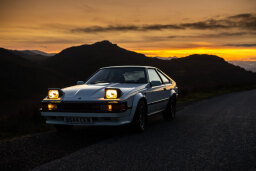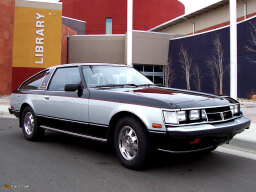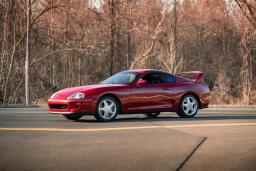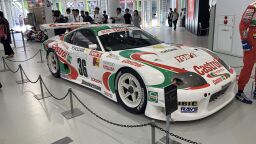
Code number: A60
In mid-1981, Toyota completely redesigned the Celica Supra as well as the entire Celica lineup for the 1982 model year. In Japan, they were known as the Celica XX, but the Celica Supra name was used for the world market. Still based on the Celica platform, there were several key differences, most notably the design of the front end and fully retractable pop-up headlights. Other differences were the inline-six rather than four-cylinder engine, as well as an increase in length and wheelbase to accommodate the larger engine. Cars installed with the 5M engine were slightly wider, while other models remained compliant with Japanese dimension regulations. The front suspension used Macpherson struts while the rear used a semi-trailing link design with an attachment at the rear differential.
In the North American market, the Celica Supra was available in two distinct models. There was the "Performance Type" (P-type) and the "Luxury Type" (L-type). While being mechanically identical, they were differentiated by the available options; tyre size, wheel size, and body trim. The P-type had fiberglass fender flares over the wheel wells, while the L-type did not. The P-type was also standard with the more sporty eight-way adjustable seats. The P-type did not get the option of a leather interior until 1983. Initially, the Luxury type meant Automatic transmission, and Performance Type stood for Manual. All editions of the P-type had the same 14x7-inch aluminium alloy wheels and throughout the years the L-type had 14x5.5-inch wheels until 1985 when they were changed to a P-type styled 15x6. The L-type also had the option of a digital instrument cluster with a trip computer; some Canadian models (both L-types and P-types) had this option as well as a few rare instances of American models. The L-type cluster was easily distinguished from the P-type cluster, by the 'ECT' function written on the dial plate. The digital cluster featured a digital tachometer, digital speedometer, and electronic fuel level and coolant level gauges. The trip computer could calculate and display various things such as fuel economy in miles-per-gallon, estimated time of arrival (ETA), and distance remaining to destination. Supras with trip computers also came with cruise control. Excluding the 1982 model, all P-types were available with headlight washers as an option, but the L-types were never given such an option. Although gear ratios changed throughout the years, all P-types came standard with a limited-slip differential.
1981
In 1981, in the North American market, the Celica Supra's engine was the 2.8-litre 12-valve (two valves per cylinder) DOHC 5M-GE. Power output was 145 hp (108 kW; 147 PS) SAE net and 155 lb⋅ft (210 N⋅m) of torque. The engine used an 8.8:1 compression ratio to achieve the power and featured a vacuum advanced distributor. When the car debuted, it had a drag coefficient of Cd=0.348, a 0 to 60 mph (0 to 97 km/h) acceleration time of 9.8 seconds and a quarter mile (400 m) time of 17.2-seconds at 80 mph (129 km/h).
The standard transmission for this year was the W58 5-speed manual with the A43DL 4-speed automatic transmission being an option for L-types. Both transmissions featured an overdrive gear and the automatic featured a locking torque converter. The top gear in the 5-speed was its overdrive whereas the automatic transmission featured an overdrive gear that would engage at speeds over 56 km/h (35 mph). The 1982 model's rear differential featured a 3.72:1 ratio. The Celica Supra's four-wheel independent suspension was specially tuned and designed by Lotus and featured variable assisted power rack-and-pinion steering and MacPherson struts up front. At the rear, it had semi-trailing arm suspension with coil springs and a stabilizer bar. Braking on the Celica Supra was handled by four-wheel disc brakes.
On the interior, this generation had standard power windows, power door locks, and power mirrors as well as a tilt steering wheel. The power door lock was located in the center console next to the power mirror control. The analog dash of this model only showed a top speed of 88 mph (142 km/h) in North America. The optional automatic climate control was renovated and was now seen as a standard feature on the A60. Cruise control and a retractable map light was standard in this generation. Some options included the addition of a sunroof, two-tone paint schemes, and a five-speaker AM/FM/MPX tuner with a cassette player (Fujitsu Ten Limited). The optional cassette stereo had a 105-watt power amplifier and a seven-band graphic equalizer. The standard stereo was a five-channel AM/FM/MPX tuner. Leather interior was an option on the L-type model, but the P-type models limited to standard striped cloth interior.
The AM/FM antenna was integrated into the front windshield rather than a typical external mast antenna. There was a key lock on the gas tank door (in lieu of a remote release) and the hatch and rear bumper were black regardless of exterior colour on the rest of the car. The P-type was available with an optional rear window visor above the hatch glass. The tail lights had a reverse light in the centre and the door handles opened the doors by pulling sideways. The front nose badge and B-pillar only read "Supra" for the first several months of production, but were changed to read "Celica Supra" midway through the model year. The L-type had front and rear mudflaps but P-type of this year did not.
1982
In 1982, for the 1983 model year, there were not many changes but there was an increase in power output to 150 hp (112 kW; 152 PS) and 159 lb⋅ft (216 N⋅m) of torque from the same 5M-GE engine. The only real change in the engine area was the switch from a vacuum advanced to an electronic advanced distributor, yet that did not increase the power output. Toyota switched to a 4.10:1 rear gear ratio for the P-type and a 3.73:1 for the L-type. As for the optional automatic transmission, they replaced the A43DL 4-speed with a newly designed A43DE 4-speed. It had an electronic controller that would adjust its shift pattern for a balance between performance and economy. It was the first in the industry to provide an electronically controlled transmission (ECT). This allowed the driver to choose either the "power" driving mode or "normal" driving mode at the touch of the button. The power mode provided the quickest acceleration and the normal mode provided the best all-around performance.
The interior virtually had no changes, but changes to the exterior included a switch to a power mast antenna, mudflaps on all models, and the addition of headlight washers on the P-type. All B-pillar and nose badges for cars sold in North America read "Celica Supra" and only the P-type was available in two-tone colour schemes.
Great Britian:
- Sold from 1982 to 1986.
- 82 to 83: 2,759 cc (2.759 L; 168.4 cu in) DOHC 5M-GE 178 hp (133 kW; 180 PS) and 212 lb⋅ft (287 N⋅m) of torque. Analog dash, no fender flares.
- 84 to 86: 2,759 cc (2.759 L; 168.4 cu in) DOHC 5M-GE 178 hp (133 kW; 180 PS) and 212 lb⋅ft (287 N⋅m) of torque. Digital dash, P-Type fender flares.





